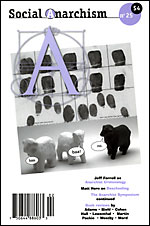Anarchists Adrift: Emma Goldman and Alexander Berkman
Anarchists Adrift: Emma Goldman and Alexander Berkman by Kenneth C. Wenzer. 114 pp. St. James, NY: Brandywine Press, 1996. $9.96 paper.
Upon reading the first few chapters of Anarchists Adrift: Emma Goldman and Alexander Berkman, I wondered why Kenneth C. Wenzer wrote this brief book. Why write a seemingly superficial overview of the lives of Goldman and Berkman? I thought that surely this information is already in print in a variety of articles, books, and doctoral dissertations. Yet, as I continued to read I was pleased to find that Wenzer offers an interesting thesis regarding these two important anarchists. I also came to realize that Wenzer, in a very concise manner, develops a social history of ideas that gives ample context for the lives of Goldman and Berkman. And finally, I found that Anarchists Adrift provides a useful introductory path for the neophyte student of anarchism and a meaningful secondary reading for history, political science, or philosophy students.
Throughout Wenzer's book he advances the thesis that Goldman and Berkman failed to articulate an anarchist system of thought and action that would appeal to more than a very small handful of Americans. The consequences of this lack of connection led the two anarchists adrift, as they could find no mooring in American society. Wenzer argues that Berkman's assassination attempt and his subsequent fourteen year prison sentence sufficiently alienated him from the working class that he sought to liberate. During the intense class conflict of the late nineteenth and early twentieth centuries, some Americans could accept workers defending themselves with arms; however, it was quite another thing to assassinate someone in cold blood. After his release from prison, Wenzer explains how Berkman attempted to find a vehicle to connect with the American working class. After several years working on Mother Earth, he found his outlet in the Blast. Even though the federal government suppressed his San Francisco publication in 1917, Berkman clearly demonstrated his commitment to labor and to the impoverished of the United States and other countries. Unfortunately, Wenzer does not adequately explain why Berkman failed to work more closely with the labor movement, especially the Industrial Workers of the World. Given his anarcho-syndicalist sympathy, it would seem natural for him to work more closely with the Wobblies. Berkman's inability to find an organizing role in the more radical elements of the American labor movement simply reinforces Wenzer's thesis. Perhaps this had as much to do with ideological purity as it did with personality. According to the anarchist printer and resident of the anarchist Home colony in Washington, Charles Govan, Berkman had an autocratic style as editor of the Blast. Govan simply argues in a letter to Joseph Labadie circa 1916 that Berkman did not work well with others.
Emma Goldman, like Berkman, lacked a firm connection to the American working class. Both anarchists thought that 'propaganda by the deed' would incite the laboring classes to revolt and usher in the social revolution. That did not happen. Berkman went to jail and Goldman, in time, worked as a lecturer and writer for the cause. Wenzer, though lacking a full account of Goldman's life during the 1890s, delves into her work as a writer and lecturer at the turn of the century and over the first two decades of the twentieth century. It is at this point in her anarchist career that Wenzer notes her distance from the masses and the elitist turn of her thinking. Unlike other radical women of her era, she did not engage in the daily work of organizing within the labor movement. The young Wobbly, Elizabeth Gurley Flynn, is a very good example of a woman who combined public speaking and writing with labor organizing. Had Goldman continued to work as a midwife, demonstration organizer for the unemployed, and pragmatic organizer for the IWW after its founding, perhaps she would not have lost her connection to the masses. However, as Wenzer points out, by the time she established Mother Earth in 1906, Goldman had adopted an elitist and somewhat vanguard notion of revolution.
The social history of ideas that Wenzer develops throughout his volume within the context of historical experience is the other major element of his work. Wenzer places both Berkman and Goldman within the Russian radical tradition and quickly traces their intellectual development in the United States. He explains their intellectual relationship to anarchists such as Pierre-Joseph Proudhon, Mikhail Bakunin, Johann Most, and Peter Kropotkin. Once Goldman and Berkman are forced to leave the United States, Wenzer continues to chart their intellectual and activist course. He follows them on their enthusiastic support and then subsequent disillusionment in Soviet Russia. Here, he finds them torn from their anarchist roots. Wenzer makes a good argument that Berkman recovered from his aberration in thinking that lead him to promote the Bolshevik government at the expense of Russian anarchists. Wenzer also explains quite well that Goldman never regained the anarchist sensibility of her earlier career even though she became a vociferous opponent of the Soviet state.
Over all I found this an interesting and accessible analytical narrative. However, I was left hungry for more information about Goldman and Berkman, especially during their work in the nineteen twenties and nineteen thirties. Wenzer does a service to his reader and other writers on Goldman and Berkman by directing readers to other sources. This brings up one troubling aspect of his book, the lack of footnotes or endnotes. Though he provides a bibliography at the end for readers to follow up on various works, his lack of citations in the text left this reader uncertain where his information and especially his quoted material originated.

